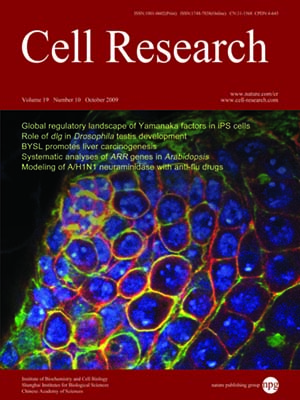
Volume 19, No 10, Oct 2009
ISSN: 1001-0602
EISSN: 1748-7838 2018
impact factor 17.848*
(Clarivate Analytics, 2019)
Volume 19 Issue 10, October 2009: 1165-1177
ORIGINAL ARTICLES
FGF-receptor substrate 2 functions as a molecular sensor integrating external regulatory signals into the FGF pathway
Wenchao Zhou1, Xiujing Feng1, Yingjie Wu2, Johannes Benge3, Zhe Zhang1 and Zhengjun Chen1
1State Key Laboratory of Molecular Biology, Institute of Biochemistry and Cell Biology, Shanghai Institutes for Biological Sciences, Graduate University of the Chinese Academy of Sciences, Chinese Academy of Sciences, 320 Yueyang Road, Shanghai 200031, China
2Innovation Center China, AstraZeneca Global R&D, AstraZeneca Pharmaceutical Co, Ltd, Shanghai 200041, China
3U3 Pharma AG, Bunsenstrasse 1, 82152 Martinsried, Germany
Correspondence: Zhengjun Chen(zjchen@sibs.ac.cn)
Fibroblast growth factor (FGF) receptor substrate 2α (FRS2α) is the main mediator of signaling in the FGF pathway. Recent studies have shown that mitogen-activated protein kinase (MAPK) phosphorylates serine and threonine residues in FRS2, negatively affecting FGF-induced tyrosine phosphorylation (PY) of FRS2. Several kinds of stimuli can induce serine/threonine phosphorylation (PS/T) of FRS2, indicating that FRS2 may be useful for studying crosstalk between growth factor signaling pathways. Here, we report that FGF-induced PY of FRS2 can be attenuated by EGF co-stimulation in PC12 cells; this inhibitory effect could be completely reversed by U0126, an inhibitor of MEK. We further identified the ERK1/2-binding motif in FRS2 and generated FRS2-3KL, a mutant lacking MAPK binding and PT upon FGF and/or EGF stimulation. Unlike wild-type (WT) FRS2, FGF-induced PY of FRS2-3KL could not be inhibited by EGF co-stimulation, and FRS2-3KL-expressing PC12 cells exhibited more differentiating potential than FRS2-WT-expressing cells in response to FGF treatment. These results suggest that PS/T of FRS2 mediated by the FRS2-MAPK negative regulatory loop may function as a molecular switch integrating negative regulatory signals from other pathways into FGFR-generated signal transduction.
Cell Research (2009) 19:1165-1177. doi: 10.1038/cr.2009.95; published online 4 August 2009
FULL TEXT | PDF
Browse 1996


